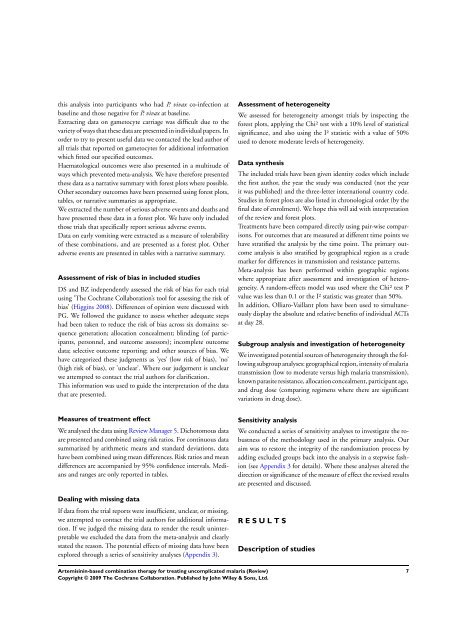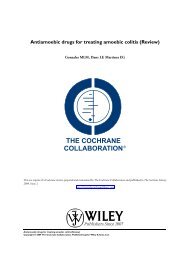Artemisinin-based combination therapy for ... - The Cochrane Library
Artemisinin-based combination therapy for ... - The Cochrane Library
Artemisinin-based combination therapy for ... - The Cochrane Library
You also want an ePaper? Increase the reach of your titles
YUMPU automatically turns print PDFs into web optimized ePapers that Google loves.
this analysis into participants who had P. vivax co-infection at<br />
baseline and those negative <strong>for</strong> P. vivax at baseline.<br />
Extracting data on gametocyte carriage was difficult due to the<br />
variety of ways that these data are presented in individual papers. In<br />
order to try to present useful data we contacted the lead author of<br />
all trials that reported on gametocytes <strong>for</strong> additional in<strong>for</strong>mation<br />
which fitted our specified outcomes.<br />
Haematological outcomes were also presented in a multitude of<br />
ways which prevented meta-analysis. We have there<strong>for</strong>e presented<br />
these data as a narrative summary with <strong>for</strong>est plots where possible.<br />
Other secondary outcomes have been presented using <strong>for</strong>est plots,<br />
tables, or narrative summaries as appropriate.<br />
We extracted the number of serious adverse events and deaths and<br />
have presented these data in a <strong>for</strong>est plot. We have only included<br />
those trials that specifically report serious adverse events.<br />
Data on early vomiting were extracted as a measure of tolerability<br />
of these <strong>combination</strong>s, and are presented as a <strong>for</strong>est plot. Other<br />
adverse events are presented in tables with a narrative summary.<br />
Assessment of risk of bias in included studies<br />
DS and BZ independently assessed the risk of bias <strong>for</strong> each trial<br />
using ’<strong>The</strong> <strong>Cochrane</strong> Collaboration’s tool <strong>for</strong> assessing the risk of<br />
bias’ (Higgins 2008). Differences of opinion were discussed with<br />
PG. We followed the guidance to assess whether adequate steps<br />
had been taken to reduce the risk of bias across six domains: sequence<br />
generation; allocation concealment; blinding (of participants,<br />
personnel, and outcome assessors); incomplete outcome<br />
data; selective outcome reporting; and other sources of bias. We<br />
have categorized these judgments as ’yes’ (low risk of bias), ’no’<br />
(high risk of bias), or ’unclear’. Where our judgement is unclear<br />
we attempted to contact the trial authors <strong>for</strong> clarification.<br />
This in<strong>for</strong>mation was used to guide the interpretation of the data<br />
that are presented.<br />
Measures of treatment effect<br />
We analysed the data using Review Manager 5. Dichotomous data<br />
are presented and combined using risk ratios. For continuous data<br />
summarized by arithmetic means and standard deviations, data<br />
have been combined using mean differences. Risk ratios and mean<br />
differences are accompanied by 95% confidence intervals. Medians<br />
and ranges are only reported in tables.<br />
Dealing with missing data<br />
If data from the trial reports were insufficient, unclear, or missing,<br />
we attempted to contact the trial authors <strong>for</strong> additional in<strong>for</strong>mation.<br />
If we judged the missing data to render the result uninterpretable<br />
we excluded the data from the meta-analysis and clearly<br />
stated the reason. <strong>The</strong> potential effects of missing data have been<br />
explored through a series of sensitivity analyses (Appendix 3).<br />
Assessment of heterogeneity<br />
We assessed <strong>for</strong> heterogeneity amongst trials by inspecting the<br />
<strong>for</strong>est plots, applying the Chi² test with a 10% level of statistical<br />
significance, and also using the I² statistic with a value of 50%<br />
used to denote moderate levels of heterogeneity.<br />
Data synthesis<br />
<strong>The</strong> included trials have been given identity codes which include<br />
the first author, the year the study was conducted (not the year<br />
it was published) and the three-letter international country code.<br />
Studies in <strong>for</strong>est plots are also listed in chronological order (by the<br />
final date of enrolment). We hope this will aid with interpretation<br />
of the review and <strong>for</strong>est plots.<br />
Treatments have been compared directly using pair-wise comparisons.<br />
For outcomes that are measured at different time points we<br />
have stratified the analysis by the time point. <strong>The</strong> primary outcome<br />
analysis is also stratified by geographical region as a crude<br />
marker <strong>for</strong> differences in transmission and resistance patterns.<br />
Meta-analysis has been per<strong>for</strong>med within geographic regions<br />
where appropriate after assessment and investigation of heterogeneity.<br />
A random-effects model was used where the Chi² test P<br />
value was less than 0.1 or the I² statistic was greater than 50%.<br />
In addition, Olliaro-Vaillant plots have been used to simultaneously<br />
display the absolute and relative benefits of individual ACTs<br />
at day 28.<br />
Subgroup analysis and investigation of heterogeneity<br />
We investigated potential sources of heterogeneity through the following<br />
subgroup analyses: geographical region, intensity of malaria<br />
transmission (low to moderate versus high malaria transmission),<br />
known parasite resistance, allocation concealment, participant age,<br />
and drug dose (comparing regimens where there are significant<br />
variations in drug dose).<br />
Sensitivity analysis<br />
We conducted a series of sensitivity analyses to investigate the robustness<br />
of the methodology used in the primary analysis. Our<br />
aim was to restore the integrity of the randomization process by<br />
adding excluded groups back into the analysis in a stepwise fashion<br />
(see Appendix 3 <strong>for</strong> details). Where these analyses altered the<br />
direction or significance of the measure of effect the revised results<br />
are presented and discussed.<br />
R E S U L T S<br />
<strong>Artemisinin</strong>-<strong>based</strong> <strong>combination</strong> <strong>therapy</strong> <strong>for</strong> treating uncomplicated malaria (Review)<br />
Copyright © 2009 <strong>The</strong> <strong>Cochrane</strong> Collaboration. Published by John Wiley & Sons, Ltd.<br />
Description of studies<br />
7








